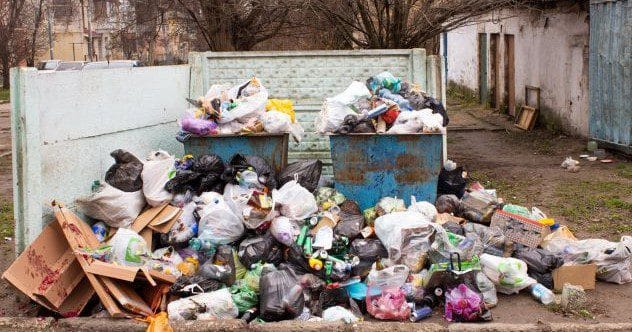How much do you know about trash? If you’re like most people, probably not much. You know enough to throw it away, right? And maybe recycle a few things for the good of the planet. But there’s a whole fascinating world hidden in our waste. Believe it or not, some very smart people have spent a lot of time thinking about trash, garbage collection, and sanitation throughout history.
In this list, we’ll dive into that world! Here are ten tidbits about trash that you never thought you’d need to know—but as you read through them, you’ll be amazed at how much there is to it!
The Work of the Zabbaleen
In Cairo, Egypt, a group of people called the “Zabbaleen” collect, sort, and dispose of garbage, making a small profit to keep the city running. These informal garbage pickers, primarily Coptic Christians, number between 50,000 and 100,000. They aren’t city employees, but they’ve been collecting the city’s trash for generations.
The Zabbaleen drive motorized or push-powered carts around the city, picking up garbage bags and other trash. They bring it back to their communities, where they break it down and sort it for recycling or disposal. Scientists have found that their recycling system is one of the most efficient in the world, with up to 80% of the trash they collect being recycled.
Bag It and Tag It!
The garbage bag seems like such an obvious invention, right? But it wasn’t until the 1950s that it became a reality. Even then, garbage bags were initially intended for commercial and hospital use to handle waste more efficiently.
In 1950, Harry Wasylyk, a Canadian inventor from Winnipeg, and Larry Hansen from Ontario, created the garbage bag. They first experimented with paper bags but eventually settled on disposable green polyethylene bags for commercial use. Wasylyk and Hansen initially sold their bags to Winnipeg Hospital before realizing the potential of the domestic market. The plastic bags were an immediate hit at home since they could contain liquids better than paper bags.
Interestingly, Frank Plomp from Toronto also invented his own plastic garbage bag in 1950. However, his bag didn’t achieve the same widespread use as Wasylyk and Hansen’s invention.
The Dempster Dumpster
For centuries, wagons were used to haul away solid waste. By the late 19th century, people sought more efficient methods. In 1897, an English company invented a steam motor tip-car specifically for trash collection.
By the 1920s, open-topped trash trucks were common but caused issues with odors and spills. Closed-top trucks emerged, but they made it difficult to dump trash efficiently. In 1937, George Dempster invented the “Dempster Dumpster,” a mechanized system that automatically lifted and dumped wheeled trash containers into the truck. Dempster’s invention revolutionized waste management and gave us the word “dumpster.”
Toss It Out… FAR Out!
Thousands of years ago, without mechanized trucks, cities had to find other ways to manage trash. In Athens, Greece, around 500 BC, residents were required to haul their garbage more than one mile outside the city limits. This ensured that trash didn’t accumulate in the streets, maintaining the city’s aesthetic appeal and preventing disease. Imagine taking a two-mile round trip every time you needed to throw something away!
Fresno Makes Trash History
In 1937, during the Great Depression, Fresno, California, opened the first sanitary landfill in the United States. This 20-acre site aimed to curb open dumping throughout the city. The landfill expanded over the years, growing to 140 acres by 1969. It operated for 50 years before closing in June 1987 and was commemorated for its impact on trash collection and public health. Fresno city officials even applied to make the landfill an officially designated National Historic Landmark in June 2023!
Terrible Trash Swirls
Plastic trash is a major global issue. In the Pacific Ocean, there are two significant garbage patches, primarily made up of plastic debris. The Great Pacific Garbage Patch, the larger of the two, has a surface area of about 618,000 square miles (1.6 million square kilometers), roughly twice the size of Texas or three times the size of France. These patches are formed by ocean currents that collect trash from around the world.
Waste Management: Japan’s Way
Japan has unique waste management practices. Despite using plastic at a high rate, the country has an exceptionally high recycling rate of nearly 90%. Strict waste management practices are in place to keep communities clean. Public littering is frowned upon, and there are limited public trash cans in major cities. As a result, people take their trash home to dispose of it properly.
Waste Management: Sweden’s Way
Sweden is a pioneer in waste management with its waste-to-energy plants. Instead of sending trash to landfills, Sweden converts it into energy to generate electricity and heat. Only about one percent of Sweden’s trash ends up in landfills. The rest is either recycled or converted into energy. By burning trash, Sweden provides electricity to over 250,000 homes and heating to another million homes and businesses.
See Ya, Space Trash!
Trash isn’t just on Earth; it’s also in space. NASA astronauts produce waste during missions, which is hauled back to Earth in spacecraft designed to burn up upon re-entry. These spacecraft, like Cygnus and Progress, are filled with trash to disintegrate in Earth’s atmosphere.
There’s also the issue of space debris, such as pieces of satellites and spaceships. The European Space Agency developed a satellite that acts like a garbage truck for the galaxy, equipped with a harpoon to collect space junk and return it to Earth.
Trash’s Final Frontier: Robotics!
Robotics and AI are revolutionizing trash collection. Robotics companies are developing automated robots that navigate cities and clean up trash. These robots can be controlled to find and collect discarded refuse. Additionally, robots like TrashBot are designed to autonomously sort trash for landfill and recycling, significantly improving the efficiency of waste management.
From ancient Athens to modern-day robotics, the world of trash is more complex and fascinating than you might have thought. These tidbits highlight the innovative solutions and ongoing challenges in managing waste across the globe.
Did these facts surprise you? Leave your comment below and share which tidbit you found most interesting!










